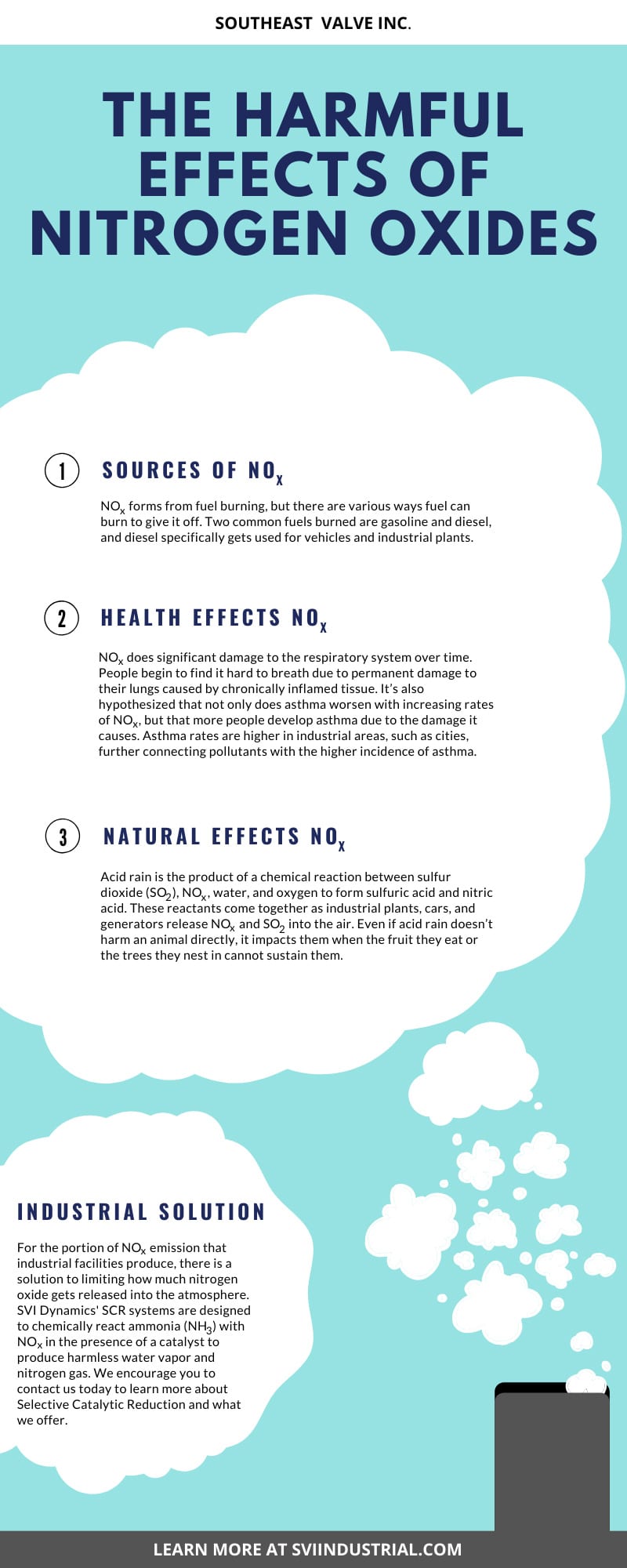
Written by Scott Schreeg | Technical
When you imagine people walking through a busy city like New York or Beijing it’s not uncommon to visualize them wearing masks to cover their faces. You may even picture a hazy brown smog in the sky. Due to industrial waste creation over the past century or two, environmental hazards such as acid rain and smog are present all over the world and inspire these visualizations of life in the city. The particular waste product responsible for these hazards is nitric oxide gas (NO), which oxidizes to form the gaseous pollutant nitrogen dioxide (NO2). As a category these are referred to as nitrogen oxides, or NOx. When it concentrates enough to yield smog and acid rain, numerous harmful health effects of nitrogen oxides present themselves, and they range from asthma incidence escalation and respiratory illness to crop and vegetation inhibition.
Background
Not to be confused with nitrous oxide (N2O) used in dental procedures, nitrogen oxides form naturally and through burning fossil fuels, such as coal and car fuel. It also is a byproduct of cigarette smoke. Nitric oxide (NO) oxidizes readily in a chemical reaction with ozone (O3) to yield nitrogen dioxide (NO2) and oxygen (O2) due to its one unpaired electron. NOx is a colorless gas with a strong odor, and it’s acidic and corrosive. Its strong reactivity is the reason behind its role in causing several different health problems.
Sources of NOx
NOx forms from fuel burning, but there are various ways fuel can burn to give it off. A 2011 EPA publication found that on-road vehicles contribute about 47% of man-made NOx emissions in the New England area, while industrial facilities emitted about 15% of total NOx. Two common fuels burned are gasoline and diesel, and diesel specifically gets used for vehicles and industrial plants. Regulations in the U.S. recently cut down on man-made emissions, but the adverse health effects still present themselves worldwide, especially in eastern countries such as India and China.
Health Effects of NOx
The most direct negative effect of nitrogen oxides is its impact on human health. NOx does significant damage to the respiratory system over time. In areas affected by smog, symptoms including coughing and throat and chest irritation commonly develop. People begin to find it hard to breath due to permanent damage to their lungs caused by chronically inflamed tissue. People who suffer from asthma also find that smoggy environments exacerbate their asthma symptoms because their bronchial passages become inflamed and hyperactive. This is a life-threatening reality for so many who live with asthma. It’s also hypothesized that not only does asthma worsen with increasing rates of NOx, but that more people develop asthma due to the damage it causes. The rate of asthma diagnosis in children has climbed for years. Though it’s still an issue being studied, there is high confidence that pollutants irritate the respiratory system and are at the root of this increase. Asthma rates are higher in industrial areas, such as cities, further connecting pollutants with the higher incidence of asthma.
Also, it was found that more children experience allergy problems—both pollen and food related—and studies indicate that fuel-burning pollution containing NOx has a strong correlation. This pollutant irritation causes what’s referred to as allergen sensitization, meaning that children react more strongly to the presence of those allergens by sneezing, swelling, itching, and presenting with a red face and runny nose. Allergic reactions can become more extreme than that; a reaction can threaten someone’s life through anaphylaxis if their airways are restricted for too long.
NOx has also been theorized to increase lung cancer risk in those exposed to high levels of pollutants from fuel burning. All of these—asthma, allergies, and cancer—are some of the more understood health risks. There are also ways NOx damages natural life.
Natural Effects of NOx
One prominent effect of excessive nitrogen oxides is acid rain. Acid rain is the product of a chemical reaction between sulfur dioxide (SO2), NOx, water, and oxygen to form sulfuric acid and nitric acid. These reactants come together as industrial plants, cars, and generators release NOx and SO2 into the air. These chemical products come back to the earth in an acidic and corrosive form, typically around 4 on the pH scale. This acid rain flows into bodies of water, often pulling aluminum from clay as it enters. Aluminum and acid harms fish and water vegetation, which causes some fish eggs to not hatch. On land, aluminum is also pulled from clay and is similarly dangerous to plants and animals. Trees and other plants are hurt when they lose sunlight-catching foliage and cannot support further growth and fruit development. When one element of an ecosystem becomes thrown off-kilter, many more facets will unbalance as well. Even if acid rain doesn’t harm an animal directly, it impacts them when the fruit they eat or the trees they nest in cannot sustain them.
Acid rain also decreases crop yields because the soil becomes acidic, and existing crops can’t flourish. Acidic products can even deposit without water’s involvement—buildings experience gradual deterioration due to the buildup of acid on their surfaces. These agricultural and architectural effects impact the economy at large, costing farmers or businesses respectively, illustrating how NOx has more wide-ranging effects than just human health concerns.
Industrial Solution: Selective Catalytic Reduction Systems (SCR)
For the portion of NOx emission that industrial facilities produce, there is a solution to limiting how much nitrogen oxide gets released into the atmosphere. SVI Dynamics’ systems are designed to chemically react ammonia (NH3) with NOx in the presence of a catalyst to produce harmless water vapor and nitrogen gas. This means that industrial by-product nitrogen oxide never leaves your plant, and it never releases into the atmosphere. Because of this, NOx cannot further contribute to existing problems involving human and environmental health. If you’re interested in addressing your facilities’ NOx emissions, SVI can provide expert SCR system implementation. We encourage you to contact us today to learn more about Selective Catalytic Reduction and what we offer.

